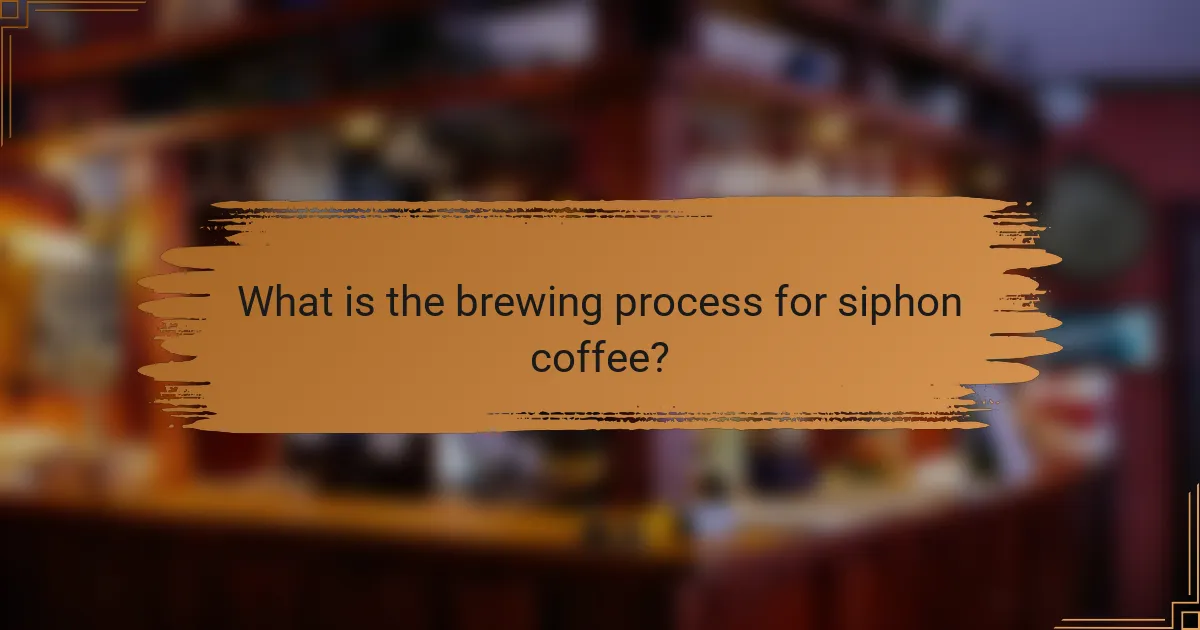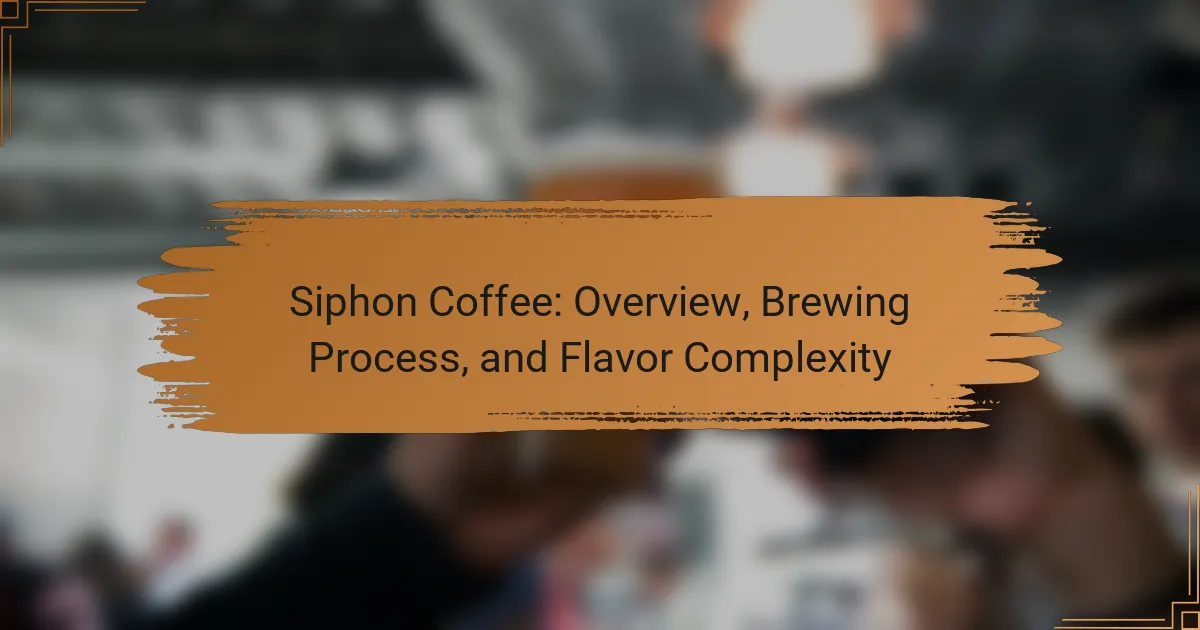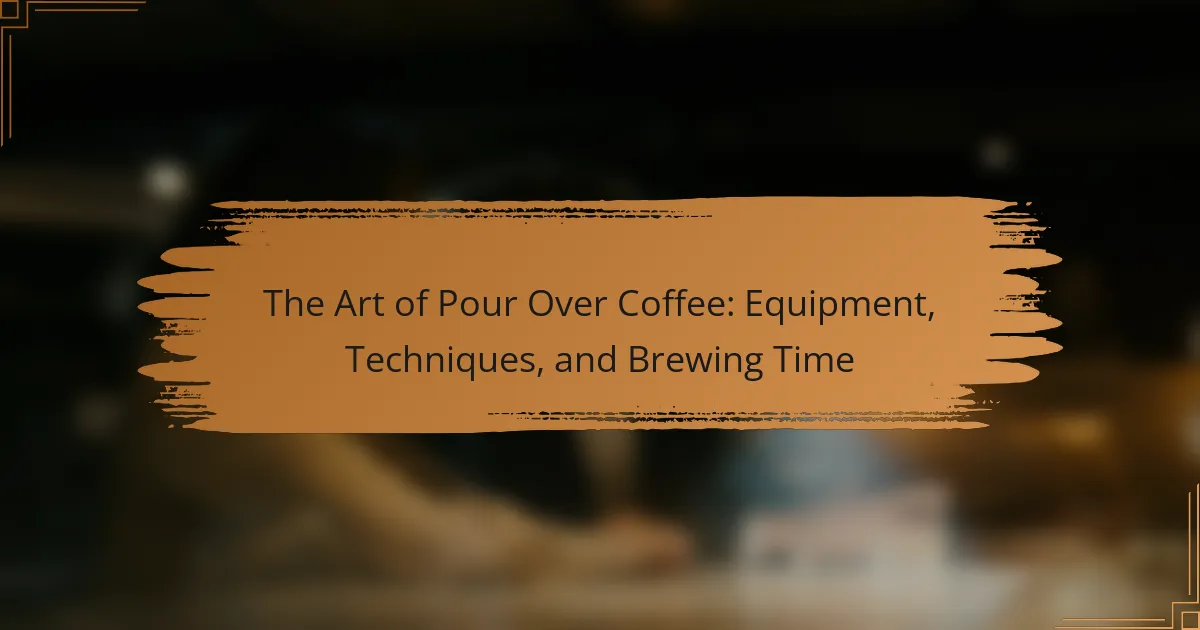
What is Siphon Coffee?
Siphon coffee is a brewing method that uses a vacuum siphon. This technique involves two chambers where water and coffee grounds interact. Heat is applied to the lower chamber, causing water to vaporize and rise to the upper chamber. Once the heat is removed, the brewed coffee is drawn back down through a filter into the lower chamber. This method is known for producing a clean and aromatic cup of coffee. The siphon coffee process emphasizes clarity of flavor and allows for precise control over brewing variables. It has origins dating back to the 19th century in Europe.
How does the siphon coffee brewing method work?
The siphon coffee brewing method works by utilizing vapor pressure and vacuum to brew coffee. It consists of two chambers connected by a tube. Water is heated in the lower chamber, creating vapor pressure. This pressure forces the water up into the upper chamber where it mixes with coffee grounds. After brewing, the heat source is removed. The vapor pressure decreases, creating a vacuum that pulls the brewed coffee back down into the lower chamber. This method results in a clean and flavorful cup of coffee. The siphon brewing method is known for its theatrical presentation and precise control over brewing variables.
What are the key components of a siphon coffee maker?
The key components of a siphon coffee maker include two glass chambers, a heat source, a filter, and a stirrer. The upper chamber holds the coffee grounds, while the lower chamber contains water. The heat source, typically a burner, heats the water to create vapor pressure. This pressure pushes the water into the upper chamber. A filter, often made of fabric or metal, separates the brewed coffee from the grounds. Finally, a stirrer is used to mix the coffee and ensure even extraction. These components work together to produce a unique brewing process that highlights the flavor complexity of siphon coffee.
How does water temperature influence the brewing process?
Water temperature significantly influences the brewing process of siphon coffee. Optimal water temperature ranges from 195°F to 205°F (90°C to 96°C). Within this range, the extraction of flavors is maximized. Higher temperatures can lead to over-extraction, resulting in bitterness. Conversely, lower temperatures may cause under-extraction, yielding a sour taste. The brewing time also varies with temperature; hotter water extracts compounds faster. Research shows that water temperature directly affects the solubility of coffee compounds. This impacts the overall flavor profile and aroma of the final brew.
What are the origins of siphon coffee?
Siphon coffee originated in the 19th century. It was developed in Europe, particularly in France and Germany. The siphon brewing method gained popularity due to its theatrical presentation. In 1830, the first patent for a siphon coffee maker was filed in France. This method uses vapor pressure and vacuum to brew coffee. The design was influenced by scientific principles of the time. By the late 1800s, siphon coffee makers were widely used in cafes. The method has since evolved but retains its unique brewing style.
Who invented the siphon coffee brewing method?
The siphon coffee brewing method was invented by a French inventor named Philippe de Girard in the 1840s. This innovative brewing technique utilizes vapor pressure and vacuum to brew coffee. The design and mechanism of the siphon coffee maker were further refined by various inventors over the years. Notably, the method gained popularity in Japan during the 20th century. The siphon coffee maker is now celebrated for its unique brewing process and the distinct flavor profile it produces.
How has siphon coffee evolved over time?
Siphon coffee has evolved significantly since its inception in the 19th century. The first siphon coffee maker was patented in 1830 by a French inventor named Joseph E. E. L. de L. H. C. de L. C. This design utilized steam pressure to brew coffee, creating a unique brewing method. By the late 1800s, siphon coffee gained popularity in Europe and Japan, leading to various design improvements. In Japan, the style and craftsmanship of siphon coffee makers became highly regarded, influencing global coffee culture. Modern siphon coffee makers often incorporate materials like glass and stainless steel, enhancing both aesthetics and functionality. Today, siphon coffee is celebrated for its theatrical brewing process and complex flavor profile. The method has been embraced by specialty coffee enthusiasts, contributing to its resurgence in cafes worldwide.
What distinguishes siphon coffee from other brewing methods?
Siphon coffee is distinguished from other brewing methods by its unique vacuum brewing process. This method utilizes two chambers where water is heated to create vapor pressure. The vapor pressure forces water into the upper chamber, mixing with coffee grounds. Once the heat is removed, the brewed coffee is pulled back down through a filter into the lower chamber. This process allows for precise temperature control and a visually engaging brewing experience. The result is a clean and aromatic cup of coffee with distinct flavor clarity. Siphon coffee’s theatrical presentation also sets it apart from standard drip or French press methods.
What are the unique features of siphon coffee brewing?
Siphon coffee brewing features a vacuum-based method that uniquely combines science and artistry. This technique uses two chambers to create a vacuum that draws water through coffee grounds. The brewing process is visually captivating, showcasing the interaction of water and coffee in a glass apparatus. Siphon brewing allows for precise temperature control, enhancing flavor extraction. The process typically results in a clean and aromatic cup of coffee. Additionally, it emphasizes the sensory experience, engaging both sight and smell. The method requires careful attention to timing and technique, making it a skillful endeavor. The unique design of the siphon apparatus contributes to its distinct brewing style.
How does siphon coffee compare to methods like drip and espresso?
Siphon coffee offers a unique brewing method compared to drip and espresso. It utilizes a vacuum process that creates a theatrical experience and enhances flavor extraction. Drip coffee relies on gravity to pass water through coffee grounds, resulting in a milder flavor profile. Espresso, on the other hand, forces hot water through finely-ground coffee under pressure, producing a concentrated shot with a rich crema.
Siphon coffee often highlights the coffee’s nuanced flavors due to precise temperature control and brewing time. This method generally takes longer than drip but less time than espresso. According to a study from the Specialty Coffee Association, siphon brewing can extract more aromatic compounds than drip methods, leading to a more complex flavor profile.
In summary, siphon coffee stands out for its flavor complexity and visual appeal, while drip coffee is simpler and espresso is more concentrated.

What is the brewing process for siphon coffee?
The brewing process for siphon coffee involves several key steps. First, water is added to the lower chamber of the siphon. The heat source is then activated to boil the water. As the water heats, vapor pressure forces it into the upper chamber containing coffee grounds. The coffee brews in the upper chamber for a specified time, typically around two to three minutes. After brewing, the heat is removed, allowing the brewed coffee to return to the lower chamber through a filter. Finally, the siphon is disassembled, and the coffee is served. This method creates a unique flavor profile due to the vacuum brewing technique.
What are the steps involved in brewing siphon coffee?
The steps involved in brewing siphon coffee include assembling the siphon, adding water, heating the water, adding coffee grounds, and stirring. First, assemble the siphon by connecting the top and bottom chambers. Next, add water to the bottom chamber, typically around 200-300 ml. Then, place the siphon on a heat source to bring the water to a boil. Once boiling, add coarsely ground coffee to the top chamber, usually a ratio of 1:15 coffee to water. Stir the mixture gently to ensure even saturation. After about 1-2 minutes, remove the heat source. The brewed coffee will then siphon back down to the bottom chamber. Finally, serve the coffee from the bottom chamber.
How do you prepare the siphon coffee maker for brewing?
To prepare the siphon coffee maker for brewing, first assemble the parts of the siphon. Ensure the top and bottom chambers are securely connected. Next, place a clean coffee filter in the top chamber. Add water to the bottom chamber, usually about halfway full. Measure and grind coffee beans, typically using a medium-coarse grind. Add the ground coffee to the top chamber. Finally, apply heat to the bottom chamber until the water boils and rises to the top chamber. This process is essential for effective brewing in a siphon coffee maker.
What is the optimal coffee-to-water ratio for siphon coffee?
The optimal coffee-to-water ratio for siphon coffee is typically 1:15. This means for every gram of coffee, 15 grams of water should be used. This ratio balances strength and flavor extraction. Using this ratio results in a well-rounded cup. Adjustments can be made based on personal taste preferences. However, sticking close to this guideline ensures a consistent brew. Many coffee enthusiasts recommend this standard for siphon brewing.
What techniques can enhance the siphon coffee brewing experience?
To enhance the siphon coffee brewing experience, focus on precise temperature control. Maintaining water temperature between 195°F to 205°F optimizes extraction. Use freshly ground coffee with a medium grind size for balanced flavor. The coffee-to-water ratio should be approximately 1:15 for ideal strength. Stirring the coffee grounds gently during brewing ensures even saturation. Allowing a 3 to 4-minute brew time maximizes flavor extraction. Using filtered water prevents unwanted minerals from affecting taste. Cleaning the siphon equipment thoroughly between uses preserves flavor integrity. These techniques collectively improve the overall siphon coffee experience.
How do grind size and coffee freshness affect the brew?
Grind size and coffee freshness significantly affect the brew quality. A finer grind increases the surface area, leading to faster extraction of flavors. This can enhance the brew’s richness but may also result in over-extraction if brewed too long. Conversely, a coarser grind slows extraction and can yield a more balanced flavor profile. Freshness is equally crucial; coffee begins to lose its aromatic compounds shortly after roasting. Research indicates that coffee beans are at their peak flavor within two to four weeks post-roasting. Using stale coffee can result in a flat, less vibrant brew. Therefore, optimal grind size and fresh beans are essential for achieving the best siphon coffee experience.
What are some common mistakes to avoid when brewing siphon coffee?
Common mistakes to avoid when brewing siphon coffee include using incorrect grind size. A grind that is too fine can clog the filter. This results in over-extraction and bitter flavors. Conversely, a grind that is too coarse may lead to under-extraction. This can cause weak and sour coffee.
Another mistake is not using enough coffee grounds. The standard ratio is about 1:15 coffee to water. Using too few grounds can dilute the flavor. Additionally, failing to preheat the siphon can affect brewing time. This can lead to inconsistent temperatures and extraction.
Not monitoring the heat source is also critical. Too high a flame can scorch the coffee. This can produce undesirable burnt flavors. Lastly, neglecting to clean the siphon properly after each use can lead to residue buildup. This can negatively impact the taste of future brews.

What is the flavor complexity of siphon coffee?
Siphon coffee has a complex flavor profile characterized by clarity and depth. This complexity arises from the unique brewing process that combines vacuum and vapor pressure. The method extracts a wide range of flavors from the coffee grounds. Siphon coffee often presents bright acidity and floral notes. Additionally, it can exhibit fruity and nutty undertones. The brewing technique also preserves the coffee’s aromatic qualities. This results in a vibrant and engaging tasting experience. Studies indicate that siphon brewing enhances the extraction of volatile compounds, contributing to its flavor richness.
How does the siphon brewing method influence flavor profiles?
The siphon brewing method influences flavor profiles by utilizing vacuum pressure to extract coffee compounds. This method allows for precise temperature control, which affects the solubility of flavors. The brewing process involves boiling water, creating vapor pressure that forces water into the coffee grounds. As the water interacts with the coffee, it extracts oils and acids that contribute to flavor complexity. The siphon method also promotes a clean cup due to its filtration system, which removes sediment. Additionally, the unique brewing environment enhances aromatic compounds, leading to a more pronounced flavor profile. Research has shown that this method can highlight sweetness and acidity in coffee. Studies indicate that siphon-brewed coffee often has a bright, crisp taste compared to other methods.
What flavor notes are typically found in siphon coffee?
Siphon coffee typically features flavor notes of fruitiness, floral undertones, and a clean finish. The brewing process enhances the extraction of these flavors. Common fruit notes include berries and citrus. Floral notes can range from jasmine to chamomile. The clean finish is attributed to the brewing method’s precision. These attributes are often highlighted in tasting notes from specialty coffee reviews. The unique siphon brewing technique allows for a complex flavor profile.
How does the brewing time affect the taste of siphon coffee?
Brewing time significantly affects the taste of siphon coffee. Longer brewing times typically extract more flavors from the coffee grounds. This can enhance the richness and complexity of the coffee. However, excessive brewing time may lead to over-extraction. Over-extraction can result in bitterness and astringency in the final cup. Optimal brewing times generally range from 1.5 to 3 minutes. This duration allows for balanced flavor extraction. Studies show that brewing within this range yields a smoother, more enjoyable taste profile.
What factors contribute to the overall taste experience of siphon coffee?
The overall taste experience of siphon coffee is influenced by several key factors. These factors include the coffee bean quality, brewing temperature, and extraction time. High-quality beans contribute to a richer flavor profile. The brewing temperature affects solubility and extraction of flavors. Optimal extraction time ensures balanced flavor without bitterness. The siphon brewing method creates a unique vacuum effect, enhancing aroma and taste. Water quality also plays a crucial role in flavor clarity. Lastly, the grind size impacts extraction efficiency, influencing the final taste.
How do water quality and temperature impact flavor?
Water quality and temperature significantly impact flavor in siphon coffee. High-quality water enhances extraction by dissolving flavors effectively. Water with impurities can introduce off-flavors, affecting the overall taste. Temperature influences the solubility of compounds in coffee. Higher temperatures extract more oils and acids, enhancing flavor complexity. Conversely, lower temperatures can lead to under-extraction, resulting in a weak flavor profile. Research indicates that optimal brewing temperature ranges between 195°F and 205°F for balanced extraction. Therefore, both water quality and temperature are crucial for achieving the desired flavor in siphon coffee.
What role does coffee bean origin play in flavor complexity?
Coffee bean origin significantly influences flavor complexity. Different regions produce beans with unique flavor profiles. Factors such as soil composition, climate, and altitude contribute to these differences. For example, Ethiopian beans often exhibit fruity and floral notes. In contrast, Colombian beans may present a balanced sweetness with nutty undertones. The processing methods used in each region also affect the final taste. For instance, washed processing can enhance acidity, while natural processing can amplify sweetness. Research shows that these variations lead to a diverse range of flavors in coffee. Understanding the origin helps consumers appreciate the complexity of their brew.
What tips can enhance your siphon coffee experience?
To enhance your siphon coffee experience, use fresh, high-quality coffee beans. Freshness significantly impacts flavor, as coffee begins to lose its aroma and taste shortly after roasting. Grind the beans just before brewing to preserve their essential oils and flavors. A medium-fine grind size is ideal for siphon brewing, ensuring optimal extraction. Use filtered water at the right temperature, ideally between 195°F and 205°F. This range helps extract the best flavors without scalding the coffee.
Maintain a clean siphon setup to avoid off-flavors. Residue from previous brews can alter the taste of your coffee. Experiment with brew time, typically between 1.5 to 3 minutes, to find your preferred flavor profile. Lastly, serve immediately after brewing to enjoy the coffee at its best flavor and aroma.
Siphon coffee is a unique brewing method utilizing a vacuum siphon, which consists of two chambers where water and coffee grounds interact through vapor pressure. This article provides an overview of siphon coffee, detailing its brewing process, key components, and the influence of water temperature on flavor extraction. Additionally, it explores the origins of siphon coffee, its evolution, and how it compares to other brewing methods, highlighting its distinct flavor complexity and the factors that contribute to the overall taste experience. Key techniques and common mistakes in siphon brewing are also discussed to enhance the brewing experience.



